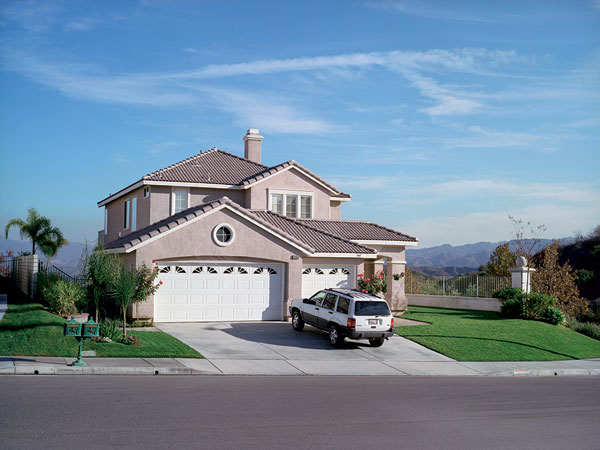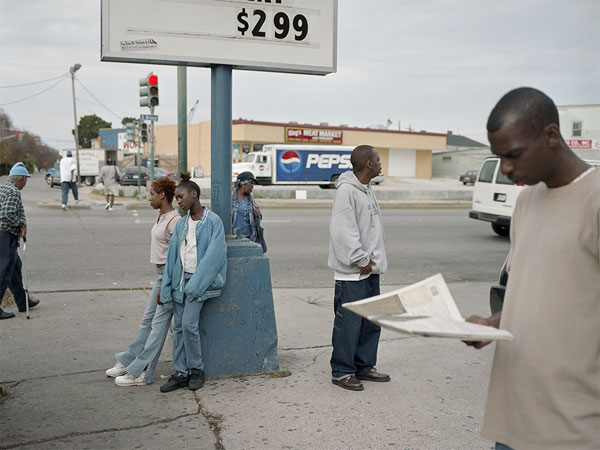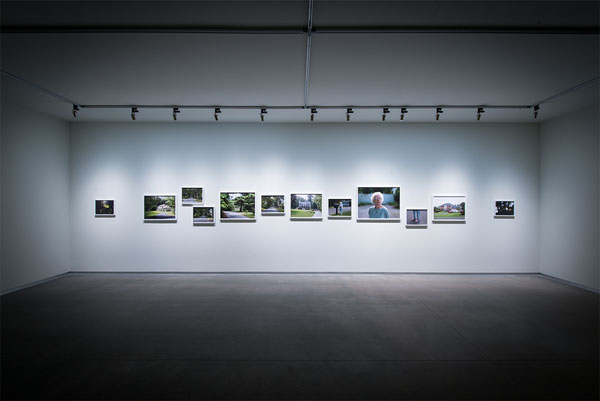Exhibition: Paul Graham on The Whiteness of the Whale at Pier 24 Photography
San Francisco’s Pier 24 Photography recently opened British photographer Paul Graham’s exhibition The Whiteness of the Whale, the venue’s first-ever presentation of a single artist. The show, which is on view until February 29, 2016, centers on three of the acclaimed photographer’s series, comprising a trilogy: American Night (1998–2002), a shimmer of possibility (2004–06), and The Present (2009–11). Through the more than sixty images on view, Graham approaches issues such as race, inequality, urban life, and poverty, while considering how the camera’s mechanics can be considered in relation to a subject. Allie Haeusslein, associate director at Pier 24, spoke with Graham about the exhibition and the thinking behind his work, his unique approach to installation, and reading Moby Dick.

Allie Haeusslein: Your exhibition at Pier 24 Photography includes three bodies of work made in the United States—American Night (1998-2002), a shimmer of possibility (2004-06), and The Present (2009-11)—and is titled The Whiteness of the Whale, a reference to Herman Melville’s Moby-Dick (1851). What was your experience reading that book?
Paul Graham: Well . . . I’m no lit graduate, but I think the book touches on many major subjects. Especially relevant here are issues of monomaniacal blindness, and how chasing one thing obsessively can drive to destruction. To be honest, I found it a hard read—inspired and crazy in places, insightful in others, racist and offensive in others again.
AH: Why did you decide to read Moby-Dick the first time?
PG: Because of American Night—the white images, the white whale, etc. We ended up using a quote from Moby-Dick on the back cover about seeing and whiteness. [“Pondering all this, the palsied universe lies before us a leper; and like wilful travellers in Lapland, who refuse to wear coloured and colouring glasses upon their eyes, so the wretched infidel gazes himself blind at the monumental white shroud that wraps all the prospect around him.”] It’s nice to return to that book now with The Whiteness of the Whale. Melville’s eponymous chapter is on the edge between genius and madness and that intrigues me.

AH: So is American Night the first project that resulted from your serious focus on making work in the U.S.?
PG: If you’re talking about the first body of work, then, yes. But you don’t start out thinking, “I’m going to make a body of work about America.” You just start taking pictures and looking for truly interesting photographs. And that can take a month, or a year, or multiple years—to find some amazing, unusual, different image, which is the gateway through which you will pass into uncharted territory. In this case, I found these overexposed white pictures, which described a sort of invisibility of the dispossessed in this country. That was a fresh visualization worth pursuing—making near-invisible photographs.
AH: Where were you making these pictures?
PG: The locations in American Night were basically along the compass points across the United States. North was Detroit; South was Memphis and Atlanta; East was New York; West was greater Los Angeles. The pictures were geographically spread out so people didn’t think, “Oh, isn’t inner-city New York terrible, or Detroit . . .” It wasn’t about one location; it was about something pervasive across the country.
AH: You made these near-invisible photographs through deliberate overexposure. How did you decide to make pictures in this way?
PG: The idea principally came about during a visit to Memphis where a portrait from End of an Age (1996–98) was in a group show. One afternoon, I went to the cinema—lazy me—and when the movie finished, I walked out a side exit door that led straight into the bright afternoon sunlight. I stumbled around thinking, “What is going on here?” While completely blinded by the brightness, I noticed this slightly unhinged guy shouting to himself as he walked across the car park. And I realized how amazing this whole scene was. With my overwhelmed, burnt-out vision, this poor man appeared to be crossing a wasteland of whiteness, unnoticed by the world.

AH: There are also very dark photographs taken in cities and bright “Technicolor” images of large homes included in American Night. How do these three different kinds of pictures work together?
PG: The earliest pictures for American Night were the dark ones. In those pictures, I was working on the streets of New York like a classic street photographer, but didn’t have any purpose for them.
Two or three years later, I discovered the white pictures. And I realized that was the breakthrough. While I wanted the majority of the images to be these near-invisible white pictures, the dark pictures were important too, as a counterbalance, and I wanted to include the American Dream—presented as glorious full-color McMansions. I worked with these three types of imagery—white, dark, and “Technicolor”—looking for ways to integrate them. Ultimately, the white images predominate; they’re around seventy-five percent of the pictures.

Allie Haeusslein: As you moved on to making pictures for a shimmer of possibility, did your working process and concerns feel like a departure from, or a continuation of, long-standing interests?
PG: In all my works, there is a similar engagement with the world through photography and the act of being in the world. shimmer also engages with the social fabric of the United States, so in that sense it’s not a departure. It is, however, structurally different with these extended, flowing sequences—the “visual haikus”—of images.
AH: You have linked the idea of the “visual haiku” to the short stories of Anton Chekhov. What is the connection?
PG: As I was reviewing scanned negatives on my computer screen, I started to notice these interesting flickering sequences. Even though I was still shooting analog, there was no traditional contact sheet. Instead, I was working with scans—digital files—of the work. As the pictures come on your screen, and you flick next, next, next, you get this stuttering sequence. The actual process of photographing, of seeing, is right there: the realization of the world as it arrives and departs on your screen.
As for Chekhov, well, he describes the most ordinary things in his short stories. There’s an openness to his simple descriptions of everyday moments. I realized these stories were connected to the sorts of pictures I was making—not nineteenth-century Russia, but today’s America—people waiting at bus stops, cutting grass, or scratching a lottery card in hopes of winning. It wasn’t so much an influence as a validation that this was a profound and worthwhile way of working, however humble it may seem.

AH: As you designed the sequences in shimmer, did you always use consecutive images, or were there instances where you eliminated exposures from the final sequence?
PG: Some pictures are left out because there’s a pause or they’re repetitious. I’m not literally showing every frame from a five-second film. That’s not the idea.
In a haiku—there’s a moment where it breaks away and touches upon the weather or the season, like “blossoms,” just a word or two, hinting at something beyond the instant concern. I tried to integrate that breakaway into some of the sequences. For instance, in the pictures with the man cutting the grass, one frame looks at his brown minivan, in all its 1980s glory. In the pictures where I’m walking behind the couple carrying home their Pepsi, I glanced to the side at some children playing in the garden with plastic bags and took a picture of them. It’s a little glance aside from the main thread—to note the sunset or the rain falling or a child playing.
AH: Was the working process for The Present—a body of work made on the streets of New York—significantly different from when you were on the road making pictures for American Night or shimmer?
PG: I lead a weird artist’s life, so I don’t go to work in midtown or a regular job where I clock-in and clock-out. When I wander around Wall Street or Midtown and experience the city’s business life, it’s like another world. And one of the great things about New York is how you can travel on the subway for just fifteen or twenty minutes and find yourself somewhere else. When you come out through another hole in the ground, you are in Ghana or Israel or Pakistan because each different neighborhood has its own ethnicities and histories.

AH: Many people are surprised to learn that the photographs in The Present were completely unstaged. Can you talk about the process of making those pictures?
PG: If you look at Winogrand’s contact sheets, he took five pictures of the same thing and then printed the one he thought was the most interesting. And that was great, of course. Likewise, I’m taking five pictures, but choosing two, or very occasionally three, to show this flowing consciousness of time, to get a different sense of the city, time, people, and life’s flow. It takes a different direction from Henri Cartier-Bresson or Winogrand, who worked to capture the singular instant, but it continues in that lineage and connects with their amazing work. In short, there’s an attempt to shift our awareness from a sort of spotlight to a floodlight.
AH: You draw our attention to the idea of seeing through repeated allusions to sight and blindness in The Present. Was that something you noticed during the editing process—that these subjects appeared in the work?
PG: It’s in American Night as well. The first and last pictures in the sequence of dark pictures in New York are of a blinded man and a woman whose eye is covered over with gauze. In The Present there are quite a few pictures of blind people with white sticks in the city. I’ve always been interested in notions of sight, seeing, and blindness. And American Night is primarily about blindness—willful blindness or psychological blindness.

AH: The installation of your work typically differs significantly from traditional modes of presenting photographs, namely the ubiquitous single line on the wall. How did you develop this unconventional approach to installation?
PG: I think I learned how to install from working on books and figuring out how to lay them out in more exciting ways. In the 1980s, I laid out my publications in a fairly classical fashion. I then started working with Scalo and their editors in the 1990s. But those books were the Scalo look, rather than my look. From then on, especially with the advent of Adobe’s InDesign program, I managed layouts myself—with American Night, then with shimmer, where we produced a twelve-volume set, and then The Present, with its multiple gatefolds.
I realized I could take what I had learned in book layout and apply it to the wall—high, low, sizes floating around, no grid. You can transfer that approach to the wall and it works very well, using gallery corners in the same way one might use the edge of a page, or you can hang high on the wall or low on the wall in the same way as on a page. But slowly, my approach to installation became its own thing, related but different.
AH: Do you think anything about your relationship to American politics is reflected in the photographs you have made in this country?
PG: Most photographers worth their salt rely on empathy and concern for their fellow citizens on this planet, rather than on political ideology. Inevitably, that empathic connection with other human beings leads one to certain sympathies. But I’m certainly not a spokesperson or a mouthpiece for the Democrats or Socialism or anything like that.
AH: You did three bodies of work in Britain, and now there are three bodies of work you’ve done in the United States. Is there something about this three-part organization that suits the way you made work in these two places?
Paul Graham: I feel it’s just a coincidence. Though, with American Night, shimmer, and The Present, there is a connection to the three principal controls of the camera—aperture, shutter, and focus . . .

AH: At what point did you become conscious of the fact these three bodies of work touch on the three controls of the camera?
PG: It occurred to me toward the end of shimmer. I also realized by using very shallow focus on the street in The Present that I could deal with specific individuals in terms of one’s awareness very effectively. And that would neatly encompass all three respects. Of course, the three camera controls—shutter, aperture, and focus—are really not that interesting in themselves. I mean—so what? But when you start to think of them in terms of the shutter controlling time, the aperture adjusting light, and the focus directing our attention or consciousness, they become a lot more powerful and fertile: time, light, consciousness.
Art often does that—it speaks both of itself and of the stuff it is made of. I like that about this work. It speaks about America, about seeing, and about photography. That makes me happy.






















